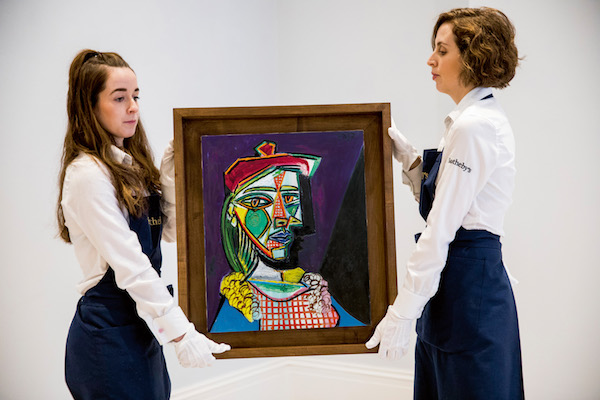AVRUPALondon, 14 January – A painting of heightened psychological intensity, Pablo Picasso’s Femme au béret et à la robe quadrillée (Marie-Thérèse Walter) brings to a climax a turbulent and highly charged year. The great masterpiece of his career Guernica was created in 1937, and in the final month of that momentous year he painted this vivid, poignant and intense image of his golden muse Marie-Thérèse Walter. This defining work will be offered for the first time as a star lot of Sotheby’s Impressionist & Modern Art Evening Sale in London on 28 February 2018.

PICASSO’S WEEPING WOMEN: THE YEARS OF MARIE-THÉRÈSE & DORA MAAR
The women of Picasso’s life are the fulcrum of his creative genius, unquestionably essential to his creative and intellectual processes. Femme au béret et à la robe quadrillée (Marie-Thérèse Walter) charts Picasso’s evolving relationship with his muse Marie-Thérèse Walter, to whom he was ostensibly still devoted at the time, and the increasingly dominant presence of his new lover Dora Maar. Indeed, the work appears to have been used as a means for exploring his feelings for the two women. There is a conscious blurring of the two styles inspired by the two muses, reaching its pinnacle in the silhouetted ‘other’ that emerges from behind the main subject. Whether it represents Maar or indeed a self-portrait, the implication is that of duality and conflict. Picasso is quoted: ‘It must be painful for a girl to see in a painting that she is on the way out’.
The beginning of the decade marked a period of sublime happiness for Picasso, as witnessed in the extraordinarily sensual and lyrical paintings of Marie-Thérèse in 1932 – which are the subject of the current acclaimed exhibition at Musée Picasso in Paris and will feature in a forthcoming show at Tate Modern in London. This extremely dynamic painting reveals just how much things had changed for him in the intervening five years. The work’s sharp cubistic edges, thick impastoed paint and black outlines give it an immediate visual impact – the emphatic execution and bold palette packed with emotional charge. The depiction of Marie-Thérèse has matured from the voluptuous curves and sleepy, passive suggestiveness to the woman who gave birth to Picasso’s child. The portrait suggests that she continued to be of central importance to the artist.
1937: GUERNICA & THE POLITICISATION OF PICASSO
These personal disruptions in 1937 were mirrored by wider political unrest in the artist’s native Spain, the year marked by a succession of shattering events including the bombing of the small town of Guernica in Basque Spain – which prompted the grand masterpiece Guernica and a harrowing series of weeping women. This portrait, with its green welling tears, has been identified as a continuation of and counterbalance to the sequence of weeping women: ‘[she is] entirely reduced to inner tears – a resigned sadness, nonetheless suffused with love.’
EXHIBITION DATES
Hong Kong 30 January- 2 February
Taipei 6 -7 February
New York 12- 14 February
London 22 -28 February
IMAGE CAPTION
Property from a Distinguished Private Collection
Pablo Picasso
Femme au béret et à la robe quadrillée (Marie-Thérèse Walter)
oil on canvas, 55 by 46cm.
Painted on 4th December 1937.


 After Nesil Caliskan a by-election will be held in Jubilee ward in Enfield
After Nesil Caliskan a by-election will be held in Jubilee ward in Enfield Publishing the analysis, Labour’s Cllr Ergin Erbil said Everybody in Enfield deserves basic rights
Publishing the analysis, Labour’s Cllr Ergin Erbil said Everybody in Enfield deserves basic rights Gaza-Israel conflict Statement from Cllr Ergin Erbil, Leader of Enfield Council
Gaza-Israel conflict Statement from Cllr Ergin Erbil, Leader of Enfield Council Cllr Ergin Erbil was elected as the new Leader of Enfield Council
Cllr Ergin Erbil was elected as the new Leader of Enfield Council History of the Turkish Cypriot People symposium held in London
History of the Turkish Cypriot People symposium held in London Asia's most famous and powerful 100 women award given to WFPA President Naziya Bisenova
Asia's most famous and powerful 100 women award given to WFPA President Naziya Bisenova Death toll climbs to 5 as powerful Storm Bert batters Britain
Death toll climbs to 5 as powerful Storm Bert batters Britain Turkish students are unable to obtain visas from the Italian Consulates
Turkish students are unable to obtain visas from the Italian Consulates Footballers are celebrating after Enfield Council officially opened a pitch
Footballers are celebrating after Enfield Council officially opened a pitch  Pep Guardiola's Manchester City beaten by Juventus
Pep Guardiola's Manchester City beaten by Juventus Chelsea to meet Arsenal in Sunday's London derby
Chelsea to meet Arsenal in Sunday's London derby Fenerbahce vs Manchester United Predicted line-ups! Jose Mourinho faces former side
Fenerbahce vs Manchester United Predicted line-ups! Jose Mourinho faces former side UK economy had zero growth between July and September
UK economy had zero growth between July and September Shape the future of housing services with The Enfield 500
Shape the future of housing services with The Enfield 500 DOUBLE-CAB PICKUPS TO BE CLASSED AS CARS UNDER NEW HMRC POLICY
DOUBLE-CAB PICKUPS TO BE CLASSED AS CARS UNDER NEW HMRC POLICY Guide to Selling Hoodies with Imprinted Book Quotes
Guide to Selling Hoodies with Imprinted Book Quotes



















